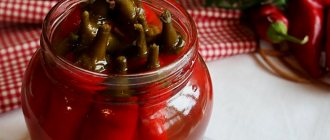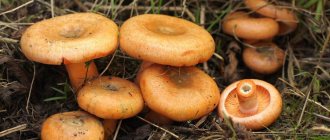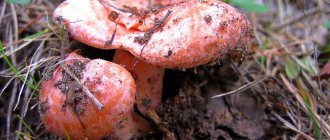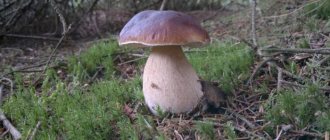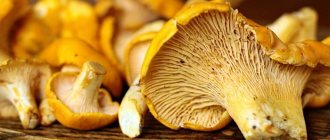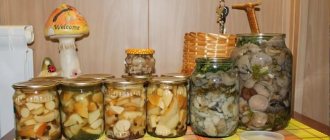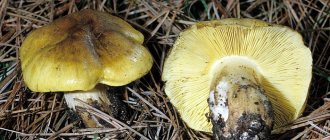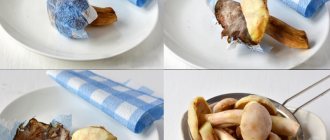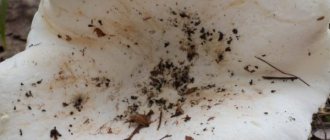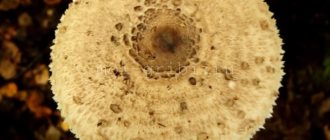Saffron mushrooms - where they grow and what they look like (photo)
Saffron milk caps have many names - common, pine, pine, autumn, noble. In essence, this is a milk mushroom, only of a different color, but just as noble. For mushroom pickers, finding it is a great success. But if you find at least one mushroom, then there must be more nearby, you just need to look for them very carefully. It is important to know the signs of where and how they can grow.
- Favorite places are coniferous forests, often spruce and pine. You definitely won’t find them in birch groves.
- Good lighting, saffron milk caps do not like shaded places. And more often they can be found in young forests, where the trees are not tall, or near the forest (on the edges and the border of the forest with meadows and clearings) or on the sides of forest roads.
- Sandy soil covered with moss, which retains moisture. In such land, the mycelium has all the conditions for its life. On dry soil or, conversely, swampy soil, you will never find them.
- A favorable factor for their growth is regularly falling dew.
The deadlines for collection are very extended. They can be found along with the first boletus in early June and even in October, when there is already a threat of the first frost. Most often, mass emergence is observed in August – early September.
Saffron milk caps are often wormy. Therefore, when collecting them, be sure to cut off the stem, so you can check whether the mushroom is wormy. Select good specimens at the stage of their collection. But if this doesn’t particularly bother you, then at home, put them in salt water for 5-7 minutes. The worms will not withstand the high concentration of salt and will come out of their holes. All you have to do is drain the water and rinse them again.
Externally, saffron milk caps look like a wave. But when you cut off the stem and turn the cap over, you will see an orange color on the cut and a milky juice of the same color oozing out. The cap of the moth is pink, has colorless milky sap and pubescent edges.
This is what they look like in the photo.
On the left is a wave, on the right is a saffron milk cap
Composition and beneficial properties
Ryzhiki are rich in mineral and vitamin composition, which makes the product one of the most useful.
Mushrooms include:
- vitamins A, group B;
- ascorbic acid;
- fiber;
- water;
- sucrose;
- ash substances.
The benefits of mushrooms are manifested in their restorative effect on the human body.
Mineral salts of iron, phosphorus, sodium, magnesium and calcium included in the product are responsible for the full functioning of all body systems and affect the health of skin, hair, and nails. The mushroom delicacy is rich in natural antibiotics that help fight bacterial diseases.
Mushrooms are valuable for the presence of amino acids and easily digestible proteins. The bright red color of the mushroom indicates the presence of beta-carotene, which is simply necessary for vision. Also, by consuming mushroom treats, you can improve digestion, cope with lung diseases, skin diseases, and prevent the formation of tumors. Camelinas are also used as an antirheumatic agent.
Recipes for making saffron milk caps - how to cook them
Having collected a rich harvest of saffron milk caps, you can not only fry them, for example, with butter and sour cream, or cook soup with them, but you can also prepare them for future use for the winter. When preparing for the winter, mushrooms are often salted or pickled.
You can pickle cold or hot. If you choose the cold method, be prepared for the color of the finished delicacy to become dark. Hot salting is good because their color does not change and remains the same.
How to store the finished product
Canned mushrooms in glass jars can be stored in the refrigerator or cellar. The optimal temperature is considered to be from 2 to 4 C; a drop below 0 C will lead to freezing of the workpiece, and the mushrooms will lose their taste. When the temperature rises above 7 C, souring and bacterial growth will begin, which will cause product spoilage.
Pickled saffron milk caps can be stored in the refrigerator at a temperature of 8-10 C for at least 40 days. At the first sign of cloudiness or the appearance of mold, the brine is drained and refilled with newly prepared brine. Pickled mushrooms cannot be stored for long periods of time, so it is recommended to consume them within a week after they are ready. To extend their life, they need to be sterilized.
When storing pickled mushrooms, it is important to ensure that the liquid completely covers the mushrooms. If there is insufficient liquid, top it up using salted water. If there is a suspicion that the process of spoilage has begun, the mushrooms can be re-boiled, hot-processed or processed into caviar.
How to pickle boletus saffron milk caps using the hot method - method No. 1
I like this method better, it is quite simple to prepare. If you use this method, the result will definitely please you. And it doesn’t matter how many mushrooms you have collected, you just need to properly prepare the brine, in which the saffron milk caps should completely fit. This method is also good because the heat treatment is minimal, which means that all vitamins and nutrients are preserved during salting.
The ingredients are taken per 1 kg of mushrooms. Depending on their ingredients, they can be proportionally reduced or, conversely, increased.
- Garlic – 2-3 cloves
- Allspice peas – 3-4 pcs.
- Cloves – 2-3 pcs.
- Dill umbrellas - 2 pcs.
- Horseradish leaves - 1-2 pcs.
For brine, take 50 g of salt per 1 liter of water.
How to salt
Step 1. First of all, we clean the mushrooms from forest debris. Then we rinse it under running water, you can use a foam sponge for washing dishes, this will make it easier to wash off any remaining debris from the cap. There is an opinion that it is enough to wipe the saffron milk caps with a dry cloth. But in my opinion, it’s better to rinse them well with water so that there are no health problems later. We pay special attention to the underside of the cap, where debris lingers between the plates and is sometimes difficult to wash out.
Step 2. Wash the dill and horseradish leaves. Peel the garlic and cut the cloves into slices.
Step 3. Prepare the brine. For every liter of hot water (but not boiling water) add 1 tbsp. l. salt with a large heap, allspice peas and cloves. I didn’t have a lot of saffron milk caps, so I prepared a little brine. Stir the liquid thoroughly until the salt crystals dissolve.
Step 4. Place a horseradish leaf and dill umbrellas on the bottom of a container or pan.
and place the washed mushrooms on it. Place dill umbrellas and chopped garlic cloves between them.
Step 5. Fill with prepared brine,
Cover the top with another leaf of horseradish. Lightly press down on the sheet so that the brine appears on its surface. You can put a little pressure on top. Leave for 1-2 hours until the brine has cooled.
You can try the brine. If your taste seems like there is not enough salt, add according to your taste. But remember that during the pickling process, the mushrooms will absorb some of the salt, and the brine will not seem so salty. So be careful when adding salt.
As soon as the brine has cooled to room temperature, the salted saffron milk caps are ready. You can already eat them. They turned out very tasty and at the same time retained their red color.
If you are preparing mushrooms for the winter, then place them in sterile jars and close the lids tightly. Store in a cool place.
Preparing the mushrooms
Before you start cooking saffron milk caps, or rather, salting them, you need to start preparing them. It is important, first of all, to sort through them, removing damaged and other defective specimens.
Note! It is advisable to select saffron milk caps of the same size for pickling, since they will be evenly salted while maintaining a juicy and elastic state.
Cleaning saffron milk caps for pickling
Before you start cleaning saffron milk caps, it is important to know that you should not put off this task, because in warm home conditions the mushrooms very quickly begin to deteriorate, become flabby, and the entire aroma of the forest evaporates into the air. In addition, such mushrooms can even become dangerous.
How to peel mushrooms depends on their future use. In some cases, you have to boil or soak the saffron milk caps, while other options require only dry peeling.
Experienced mushroom pickers begin cleaning saffron milk caps directly in the forest. To do this, you only need a small sharp knife, which removes defective areas and cleans out the most severe contaminants, such as adhered dirt. You also need to immediately remove the roughened part of the mushroom stem. Thanks to this, you can immediately consider the likelihood of damage to the product by worms.
Cleaning mushrooms by boiling is only suitable for hot canning, which involves heat treatment. To do this, you need to fill the mushrooms with water, add a little salt and boil for 5 minutes.
With the cold salting method, cold-type pre-treatment will also be required.
Soaking mushrooms
Beginners and inexperienced housewives often have the question of whether it is necessary to soak saffron milk caps before pickling, and how to do it correctly. And, as mentioned earlier, this process is necessary for the cold salting method.
It consists of the following stages:
- First, you will need to remove any adhered dirt and leaves. An ordinary kitchen sponge and a damp, clean cloth will help with this. An old toothbrush will also do a great job of removing dirt between the plates.
- Remove the coarsened lower part of the legs and rinse the mushrooms in a deep container.
- Drain the dirty water, fill it with clean water and add 2 tablespoons of salt to it. When choosing a container for washing mushrooms, it is important to pay attention to the fact that it must be made of non-metallic material.
- Leave the mushrooms in that water for several hours. Then drain the water and rinse the saffron milk caps under running cold water. Leave for a while to release excess moisture.
Now you can start pickling the mushrooms.
Hot salting of saffron milk caps in jars – method No. 2
When salted in this hot way, the mushrooms remain natural in color. They turn out quite strong, crispy and, of course, tasty. And they are perfectly stored until the next season.
How to cook
Step 1. The saffron milk caps are sorted and washed with water.
Step 2. Pour water into the pan and add salt at the rate of 50 g of salt (2 tbsp) per 1 liter. Place the mushrooms in the brine and let them simmer for 10 minutes.
Step 3. While the saffron milk caps are boiling, prepare the marinade. For 1 liter of water take:
- 2 tbsp. l. Sahara
- 4 tsp. salt
- 4 bay leaves
- 6 allspice peas
- 3 cloves.
- 3 pieces of cinnamon (or 0.5 tsp ground)
Step 4. Place the boiled mushrooms in a colander and immediately place them in pre-sterilized jars.
Step 5. Fill with hot brine and immediately roll up the jars with lids.
From 1 kg of boiled saffron milk caps, one liter jar of the preparation is obtained.
In English
Ryzhiki, salted hot in English, are moderately spicy, satisfying and aromatic. It is better to preserve saffron milk caps in small jars so that the mushrooms are not stored for a long time when opened.
What ingredients will you need?
Ingredients for the recipe:
- 1 kg of different sized saffron milk caps;
- 100 ml table wine;
- 100 ml extra virgin olive oil;
- salt – 20 g;
- 20 g sugar;
- 20 g grainy Dijon mustard;
- onion head
Step-by-step cooking process
Step-by-step preparation of saffron milk caps:
- Blanch freshly picked saffron milk caps for up to 5 minutes in salted boiling water.
- Strain the mushrooms, rinse in cool water and divide into medium pieces.
- Pour red wine and butter into a saucepan, add salt to the mixture and sprinkle with sugar.
- Chop the onion into rings and pour into a saucepan with the wine. Add Dijon sweetish mustard there.
- Boil the mixture, then place the mushrooms in a saucepan and cook over medium heat for 5 minutes.
- Distribute the mushroom mass into sterilized jars, cover with lids and store in the refrigerator.
Rich mushroom caviar with a slight piquancy from the wine is ready for tasting in 4 days.
A simple recipe for cold pickling of saffron milk caps
Ryzhiki are one of those mushrooms that, when pickled, do not require the addition of pepper, garlic or other spices. They are delicious on their own. And raw foodists even eat them, simply dipping a piece into a salt shaker. However, most of us prefer to eat them salted.
The cold salting method is the simplest; the main thing here is not to overdo it with salt. Salt is taken here based on 1 kg of mushrooms: 40 g of salt - 1 tbsp. l. salt with a large slide.
How to cook
Step 1. The saffron milk caps need to be washed or even soaked for half an hour in cold water. However, if you plan to cover them later, for safety reasons and to prevent botulism, it is still better to rinse them thoroughly.
Step 2. Place the mushrooms in layers with salt into a wooden or enamel container. It is better not to use aluminum cookware, since oxidation is likely to occur and this is also not very good for health.
So we lay them all out, sprinkling each layer with salt.
By the way, mushrooms contain the antibiotic lactrioviolin, which is good for treating tuberculosis and other lung diseases. And if you accidentally get injured in the forest, apply a piece of camelina to the wound, this will speed up its healing. This healing patch will also help with insect bites.
Step 3. Place a plate on top and put pressure on it.
Leave the container in a cool place to pickle the mushrooms. And after 3-4 days they are ready to eat.
With garlic
Garlic provides the preparation with pungency and a pleasant aroma.
What ingredients will you need?
Required set of products:
- 2 kg of mushrooms;
- 10 pieces. black peppercorns;
- 20 g horseradish root;
- 7 cloves of young garlic;
- 40 g fine salt.
Step-by-step cooking process
Hot salting method step by step:
- Remove mushrooms from branches and debris. Cut large specimens into large pieces, and leave small ones whole.
- Pour cold water over the saffron milk caps in a saucepan, put it on the stove and boil for 15 minutes, then strain the liquid and cool the mushrooms.
- Rub the horseradish root with a fine grater and chop the garlic into cubes.
- Mix all prepared ingredients in a bowl, cover with a plate on which to place a weight.
- Place the pickles on the bottom shelf of the refrigerator or place them in the cellar for 4 days.
Serve mushrooms with finely chopped onion rings and fresh dill.
Recipe for quick-cooking salted saffron milk caps
You can eat saffron milk caps raw, just sprinkle them with a little salt. But it's better not to take risks. And if you really want to quickly enjoy the taste of the delicacy, try pickling them according to a quick recipe. The mushrooms will be ready in 2 hours and can be safely eaten.
In this way, it is best to salt a small amount of saffron milk caps, otherwise they will become over-salted and will simply be impossible to eat.
Quantity of ingredients
- Ryzhikov - take about 500 g
- We use more salt than with regular salting. If for regular salting you take 2 tbsp per 1 kg of forest products. l. salt with a large heap, then for quick salting it is taken 5 times more. By simple calculation it turns out that for every 100 g of saffron milk caps you need to take 1 tbsp. l. salt.
How to salt
Step 1. Wash the mushrooms and cut off their stems, since the stems take much longer to salt than the caps.
Step 2. Pour a little salt into the bottom of a small bowl, place the caps on top, and sprinkle each layer with salt.
Then cover the bowl with a plate, put a little pressure on it and put it in the refrigerator for exactly 2 hours. If you overdo it even a little, the mushrooms will turn out too salty. And that’s why it’s better not to add salt to them than to over-salt them.
Step 3. After 2 hours, we take the saffron milk caps out of the refrigerator, they have already given juice. Place them in a colander and rinse them under running water to remove excess salt.
Once washed, transfer them to a clean plate. This delicacy should be eaten as soon as possible, preferably within 24 hours.
When serving, add onion, cut into thin rings or half rings, to the plate with mushrooms. If desired, you can season with a little chopped garlic. Season with sour cream or vegetable oil and serve.
How to pickle saffron milk caps for the winter with vinegar - a simple recipe
Open a jar of pickled saffron milk caps, boil some potatoes and invite your loved ones to the table. You will arrange a wonderful and satisfying budget dinner for your family. And how good they are marinated for the holiday table! Try to cook them according to this recipe, you will definitely like them!
Ingredients
- Ryzhiki – 500 -600 g
- Bay leaf – 2 pcs.
- Allspice peas – 5 pcs.
- Cloves – 3 pcs.
- Acetic acid 70% - 0.5 tsp.
- Water – 100 ml
- Salt – 1 tbsp. l.
How to marinate
Step 1. Mushrooms are sorted out from debris and washed.
Step 2. Pour some water into the pan and transfer the prepared saffron milk caps there. Don't worry that there is not enough water. During the cooking process, they will release juice, it will be quite enough, and they will cook on it.
Step 3. Throw bay leaf, peppercorns and cloves into the pan. Since there are only a few saffron milk caps, 1 tbsp is enough for this amount. l. salt. If you need to marinate more mushrooms, increase the amount of spices and salt proportionally.
The brine should be slightly salted. When the mushrooms are in the jars, they will absorb excess salt and they will become very tasty.
Step 4. Close the pan with a lid and cook for about 7-10 minutes from the moment it boils. While cooking, taste the broth; it should be a little salty.
Step 5. Turn off the stove, and when the contents of the pan stop bubbling, add 0.5-1 tsp of saffron milk caps (about 0.5 liters) to this amount. acetic acid.
And while the mushrooms are hot, transfer them immediately into pre-sterilized jars. Lightly compact with a spoon, add a little marinade and close tightly with a plastic lid.
When the jars have cooled, put them away for storage in a cool place - in the refrigerator or underground.
Wet and dry salting method
If you have not yet tried to stock up on orange forest gifts, but have decided to experiment, prepare the following ingredients for the first recipe that we will study - cold pickling.
We will need: 2 kilograms of saffron milk caps, 100 grams of salt, 30 black peppercorns, 8 cloves, 1-2 horseradish leaves, 2 currant leaves, dill/garlic - optional. Below are step-by-step cooking instructions, following which will save you from troubles in the form of a spoiled dish:
- Carefully sort through the forest harvest, getting rid of damaged, old or spoiled specimens.
- Thoroughly rinse the mushrooms from debris, soil and dust, refresh the stem cut. If traces of worms are found in the pulp, remove the stem and examine the cap; perhaps it remains intact, which means it is suitable for food.
- If it is fundamentally important for you to make sure that the fruiting bodies do not hide crawling insects, prepare a salty solution and place the mushrooms in it. After 10 minutes, all insects will leave their “shelters”.
- Rinse the selected plants under running water so as not to damage them with strong pressure, then place them on a cloth that absorbs moisture well. Your goal is to get rid of excess fluid.
- Prepare a container suitable for pickling, it can be a saucepan or a large jar. Some housewives begin to salt reserves in large saucepans or basins, because it is more convenient to get to the workpiece, which means to replenish it as soon as the first batch of mushrooms settles, having lost excess liquid.
- Place a horseradish leaf on the bottom of the container. Not everyone knows that horseradish is a protection against bacteria and fungi; it simply prevents mold from forming. You can also add pepper and currants with dill - natural seasonings will add a special piquancy to the dish.
- Chop the garlic, measure out about one-fifth of the salt and add the ingredients to the pan, spreading it evenly.
- Place a fifth of clean mushrooms, caps down.
- “Double” a layer of salt with garlic, then mushrooms again.
- Approximately in the middle of the “construction” again add horseradish, dill, peppercorns, and clove flowers.
- Continue alternating layers of saffron milk caps and salt, finishing with a layer of food crystals.
- Cover the workpiece with several layers of gauze, then a lid, and then place it under pressure. Further preparation will take 15-18 days, and the product should be in a cool room (at a temperature no higher than 18 degrees Celsius). It is strongly recommended to replace the gauze at least once every two days. After several weeks, you can transfer the mushrooms to a jar - now saffron milk caps should be stored in the refrigerator for the winter.
Cold pickling
Fans of cold salting using the dry method should repeat all the described manipulations, with the exception of the stage at which the saffron milk caps are washed or soaked in water. Just take a damp paper towel or wet cloth and wipe each mushroom to remove any dust/contaminants. In this case, it is fundamentally important to get rid of all fruiting bodies damaged by worms (of course, if you do not want to flavor the delicacy with creeping meat).
It is worth noting that the main ingredients of both recipes are exclusively salt and mushrooms; all other ingredients are added based solely on individual preferences, because some people do not like dill, while others do not like garlic. You can spice up the dish by seasoning it with any additives familiar to your family.
Experts who have “eaten dog” when it comes to pickling saffron milk caps or other mushroom crops recommend not preparing large quantities of appetizers if you are a beginner and have no experience with a particular recipe. To begin with, you should take a small “batch” of the product and experiment; you may not like the result and will require individual modification.
Fried saffron milk caps in sour cream
Until recently, I didn’t even know that saffron milk caps could be fried. It turns out, like white boletus or boletus, they can also be fried. And if you add potatoes and sour cream, the dish will turn out to be delicious!
Ingredients
- Fresh saffron milk caps – 400 g
- Potatoes – 4 medium tubers
- Onion – 1 head
- Sour cream - 2 tbsp. l.
- Butter – 50 g
- Vegetable oil for frying – 1-2 tbsp. l.
- Salt and pepper - to taste
Watch how to prepare such a simple dish in a short video.
Dear readers, if you are lucky enough to find saffron milk caps in the forest, use these recipes and pickle or pickle them for the winter. Or just fry them with potatoes and sour cream and delight your loved ones.
Bon appetit!
Video
We invite you to watch a few more simple recipes for pickling saffron milk caps according to original recipes from experienced housewives in the following videos:
For recipes for cold pickling of saffron milk caps, see this article.
Recipes for pickling saffron milk caps are in this article.
Freelancer with diverse interests and hobbies. Likes to be close to nature, eat delicious food and philosophize about the eternal. She has been writing articles on a variety of topics for so long that she is already erudite in the most unexpected areas. Loves forests, flowering gardens, space and fried potatoes with smoked ribs. He doesn’t like to stand at the stove, but among his friends there are several professional chefs who will always feed you delicious food and share cool recipes. Pathologically optimistic.
Found a mistake? Select the text with the mouse and click:
Humus is rotted manure or bird droppings. It is prepared like this: the manure is piled up in a heap or pile, layered with sawdust, peat and garden soil. The pile is covered with film to stabilize temperature and humidity (this is necessary to increase the activity of microorganisms). The fertilizer “ripens” within 2-5 years, depending on external conditions and the composition of the feedstock. The output is a loose, homogeneous mass with a pleasant smell of fresh earth.
The homeland of pepper is America, but the main breeding work on developing sweet varieties was carried out, in particular, by Ferenc Horvath (Hungary) in the 20s. XX century in Europe, mainly in the Balkans. Pepper came to Russia from Bulgaria, which is why it received its usual name - “Bulgarian”.
One of the most convenient methods for preparing a harvest of vegetables, fruits and berries is freezing. Some believe that freezing causes the nutritional and health benefits of plant foods to be lost. As a result of the research, scientists have found that there is practically no decrease in nutritional value when frozen.
In Australia, scientists have begun experiments in cloning several varieties of grapes grown in cold regions. Climate warming, which is predicted for the next 50 years, will lead to their disappearance. Australian varieties have excellent characteristics for winemaking and are not susceptible to diseases common in Europe and America.
“Frost-resistant” varieties of garden strawberries (more often simply “strawberries”) need shelter just as much as ordinary varieties (especially in those regions where there are snowless winters or frosts alternating with thaws). All strawberries have superficial roots. This means that without shelter they freeze to death. Sellers’ assurances that strawberries are “frost-resistant,” “winter-hardy,” “tolerates frosts down to −35 ℃,” etc. are deception. Gardeners must remember that no one has yet managed to change the root system of strawberries.
In little Denmark, any piece of land is a very expensive pleasure. Therefore, local gardeners have adapted to growing fresh vegetables in buckets, large bags, and foam boxes filled with a special earthen mixture. Such agrotechnical methods make it possible to obtain a harvest even at home.
Convenient Android applications have been developed to help gardeners and gardeners. First of all, these are sowing (lunar, flower, etc.) calendars, thematic magazines, and collections of useful tips. With their help, you can choose a day favorable for planting each type of plant, determine the timing of their ripening and harvest on time.
Both humus and compost are rightfully the basis of organic farming. Their presence in the soil significantly increases the yield and improves the taste of vegetables and fruits. They are very similar in properties and appearance, but they should not be confused. Humus is rotted manure or bird droppings. Compost is rotted organic remains of various origins (spoiled food from the kitchen, tops, weeds, thin twigs). Humus is considered a higher quality fertilizer; compost is more accessible.
It is believed that some vegetables and fruits (cucumbers, stem celery, all varieties of cabbage, peppers, apples) have “negative calorie content,” that is, more calories are consumed during digestion than they contain. In fact, only 10-20% of the calories received from food are consumed in the digestive process.
- Author: Maria Sukhorukikh
Rate this article:
- 5
- 4
- 3
- 2
- 1
(0 votes, average: 0 out of 5)
Share with your friends!
